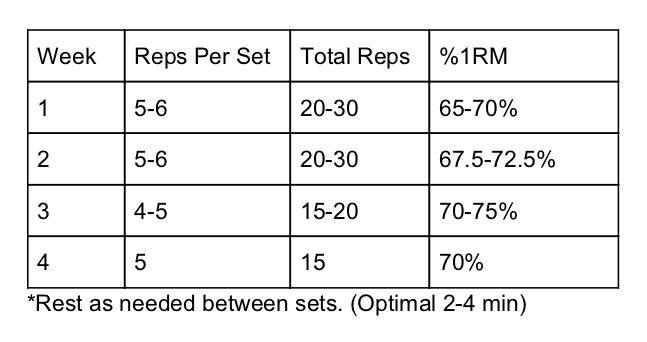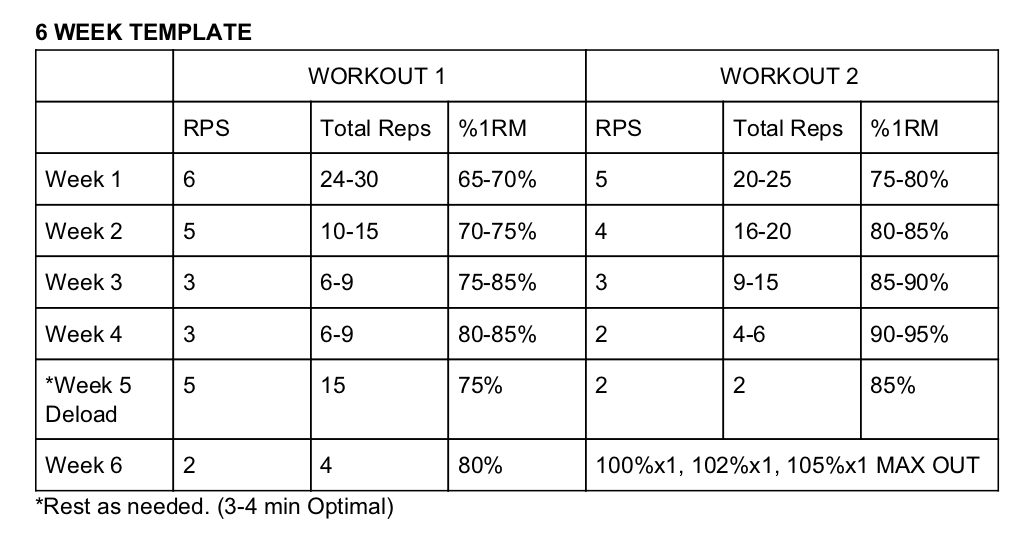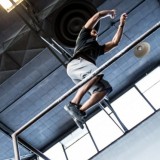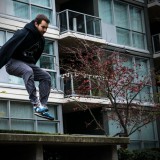Parkour Off-Season Training Bible Pt. 1
Parkour Off-Season Training Bible Pt. 1

“It is necessary sometimes to take one step
backward to take two steps forward.”
Disclaimer: The following program is designed for athletes. If you train only 1-3 times per week this is going to sound like a lot and might not be for you. Having said that, this could be the perfect template to bring organization to your training, get you out more, and up your overall game.
Primary Lifts
Primary Lifts will happen in every workout after some initial upper or lower body dynamic work. The dynamic work and the primary lifts in this phase are submaximal, so both will be achievable in the same session.
At the top of the program you will find a table labeled “Primary Lifts Progression”. This is where you will go to find the sets and repetitions you will do for the primary movement. The first thing you will notice is that I do not give a precise number; instead there is a range of repetitions, and an amount of total repetitions to shoot for. This allows the program to be modified for a broader range of people. For example: on week 1 you can do 5-6 reps per set, and 25-30 total reps, so acceptable formulas for reps/sets would be: 5×6, 6×5, or 5×5 (4×6 would also be acceptable even though it is one rep short of the minimum, but that can be our little secret 😉 )
The percentages on the chart are based off of existing “One Rep Maximum(s)”. This could also be interpreted as a “Rate of Perceived Exertion” (RPE). Either way, the concept of progressive overload is simple, and I am not trying to reinvent the wheel or sell you anything weird here. This is simply what works to build strength. The fact that the reps and sets are flexible also means that the percentage can be flexible. Feel free to interpret it how you will, but make sure to follow the slow incremental progress as outlined for best results.
Example Week 3.
| Reps Per Set | Total Reps | %1RM |
| 4-5 | 15-20 | 70-75% |
The percentage is 70-75, which means you could perform each set at a different weight, or all of them at the same weight. If you decide to perform 4 sets of 5 reps, your workout could look like 5×70%, 5×72%, 5×74%, 5×75%, or it could simply be 4x5x70%, or 4x5x75%. All of the above repetition and percentage schemes are acceptable.
The foundation phase should feel fairly easy, because the weights are well below your maximum. Don’t feel unaccomplished for not lifting until failure. Just enjoy getting into the groove of consistent workouts!
Repeated Effort Method
If the primary movements are based off of the maximum effort method, all of the following movements are the repeated effort method. These exercises are done to build hypertrophy and strength in specific areas or ranges of motion. Try to take shorter rest periods between sets for these movements, and account for this when choosing your weight.
I have only provided a range for total repetitions. This means there are a lot of different set/rep schemes that could work. As long as the rest periods are kept at a minimum it’s all pretty much the same. If the total repetitions you’re shooting for is 50 you could do 10×5 and feel very focused during each set, because you’re only doing 5, or you could do 5×10 if you feel like the exercise doesn’t require much focus and you just want to get it done, or 4×12-13, 3×15-17, etc.
Parkour Skill Work
Yes, you can and should do parkour outside of the prescribed strength and conditioning program. I recommend making a list of singular skills to work on during the off-season. You can also train lines and have haphazard sessions, as long as you are monitoring and recording your intensity. You can use “RPE” (Rate of Perceived Exertion) to monitor intensity just like you do for lifts. Try to keep most of your training below a 7 or an 8, and do not push the amount of repetitions you do. For example: let’s say your max standing pre distance is 10 feet. So you would only do jumps 8 feet or less, but not do 50 jumps at 8 feet or it will feel like you did a 9 or a 10 training session.
A good way to stay true to your RPE is to do your parkour training after workouts. Even if it’s later in the day you will be too fatigued to over do it. You can also fit in parkour training on Off days. In the schedule for each training block you will find the strength & conditioning schedule, as well as an example of a schedule that incorporates parkour training.
What happens if you overdo it in a session? Maybe you get really inspired, you feel strong from all of the general strength work, and you set your eyes on a challenge you can’t resist. This challenge takes a number of attempts, and before you know it you’ve blown 10 attempts, nailed the challenge, but clearly outdone yourself. If this is the case you should skip a WORKOUT or at least skip the speed work and the primary movement. You need to recover to get stronger, so it’s counterproductive to do too much. Plus if you’re getting so much better that you are able to achieve new challenges, then the program is doing its job already. As long as you’re not missing workouts all the time everything should be fine.
If you have a really disorganized or stressful week and miss most of your workouts, I would recommend simply repeating the week.
Tempo Workouts, and Deloading
“Off” days are also marked as “Aerobic” and “Recovery” days. You could also do an Aerobic workout earlier in the day before a WORKOUT. Tempo training or circuit training are the best methods of aerobic workouts for speed/power athletes. I recommend trying to hit 2-3 tempo workouts in a week.
Tempo workouts are meant to be low intensity. Do not get tempo workouts confused with high intensity interval training. You should feel better at the end of the session, than you did at the start. If you are breathing heavy you are working too hard and need to dial back the intensity.
- 30 Seconds of “Cyclic” movement at 70-80% intensity: sprinting, cycling, skipping, swimming, running on the spot, etc. Choose something low impact.
- 30 Seconds of a low intensity exercise or drill. Push ups, sit ups, lunges, small precision jumps, physio exercises, etc. (Pick 2-8 exercises to go through)
- 30 Seconds rest.
Repeat this for a number of rounds or just stick to it for 20-30 min.
You can warm up before the tempo workout and follow it with stretching.
A *deload week is taken every 3-5 weeks depending on the program. During the deload week you have two options: 1. Completely take the week off and just do a couple of tempo workouts to help promote blood flow and increase recovery.
- Do the same workout schedule, but in each workout do half of the amount of reps/sets you normally would. Avoid impact on your joints and use less weight on the primary movements to “Deload” your spine. You will find lighter weight and fewer rep recommendations for primary movements on deload weeks.
Work-Up Sets
Work-up sets should be done for each primary movement. Work Up sets are basically a technique used to stimulate your nervous system and prepare it to switch on more motor units for each following set. Using work up sets not only makes lifting heavy weights safer, but you will also be more successful at performing your primary lifts. Here is a standard model you can follow:
45% x 6-8
55% x 5-6
65% x 5
As the weight gets heavier you can add in another Work-up set every 5-10%.
For example: Working weight = 85%x4. Perform above sets followed by 75%x4, 80% x4, and then the work sets. Rest between work sets should be 1-3 min.
FOUNDATION BLOCK
The Foundation Block is 3 weeks long, plus one “deload” week. The purpose is to start with lighter loads at higher volumes in order to build up work capacity and technique in each movement. The primary lower body movements in this phase are unilateral to emphasize work on stability before we jump in to bilateral lifts for maximal strength and nervous system recruitment.
Schedule
Monday – WORKOUT Ai
Tuesday – WORKOUT Bi
Wednesday – Off / Aerobic / Recovery
Thursday – WORKOUT Aii
Friday – WORKOUT Bii
Saturday – Off / Aerobic / Recovery
Sunday – Off / Aerobic / Recovery
Schedule + Parkour Workouts
Notice that most of the parkour drills occur after workouts or on the off days, and the more loosely defined “session” workout occurs on Saturday. By doing your PK skills after the strength & conditioning work you will likely be too fatigued to go too hard. For the same reason you could plan to have a looser and more challenge based session on Saturday at the end of a long week of training. Sunday could then be reserved for recovery.
Monday – WORKOUT A / PK Drills
Tuesday – WORKOUT B
Wednesday – Aerobic / PK Drills
Thursday – WORKOUT A / PK Drills
Friday – WORKOUT B
Saturday – Aerobic / PK Session
Sunday – Off / Aerobic / Recovery
Primary Lifts Progression
WORKOUT A – Sprints, Jumps, & Upper Body Weights
A. Sprinting Drills: Perform each of these 1-3 times before your sprinting work.
- A-March
- A-Skip
- Running-A
B. Short Sprints: Pick one of the following variations for a 10m Sprint and Perform 6-10 Sprints with 30-45 seconds rest between them.
- Split-step start
- Push-Up Start
- Med Ball Throw to Sprint
- 3 or 4 point start
C. Single Leg Bounds (Submaximal) – Perform 3-5 jumps per leg, for 20-30 total reps for each leg. Rest as needed.
- Use a slight hill or plyo boxes to mix in performing these going upwards.
D. Upper Body Primary Movement – Pick one “Pressing” movement for Workout Ai, and one Pulling movement for Workout Aii.
Pressing (Ai)
- Bench Press
- Incline Bench Press
- Weighted Dips
Pulling (Aii)
- Weighted Chin-Ups
- Weighted Pull-Ups
- Barbell Rows
E. One Arm Movement – Pick one “Pulling” movement for Workout Ai, and one “Pressing” movement for Workout Aii. Do 40-60 total reps.
Pulling (Ai)
- One Arm DB Row
- One Arm Cable or Band Row
- One Arm Landmine Row
Pressing (Aii)
- DB Incline Press
- DB Bench Press
- Med Ball “One-Arm” Push-Ups
F. One for the Delts – Pick one of the following for 40-60 total reps.
- DB Lateral Raise
- L-lateral Raise
- Band or Cable Lateral Raise
- DB Military Press
G. Elbow Flexors / Extensors Superset – Don’t feel like listing all the possibilities, but pick two exercises and hit 12-20 reps of each for 3 sets.
- Bicep Curls
- Tricep Extensions
WORKOUT B – Dynos & Lower Body Weights
A. Dynamic Climbing Movement – Pick one of the following and perform 3-5 reps, for 15-30 total reps.
- Dyno
- Climb-Up
- Cat-Back
B. Single Leg Movement: (see Primary Lifts Progression)
- Step-Ups
- Bulgarian Split Squats
- Reverse Lunge
- Single Leg Deadlift
C. Secondary Single Leg Movement. Pick one “Post-Chain” movement for Workout Bi, and one “Quadriceps” movement for Workout Bii. Do 30-50 total reps for each leg.
Post-Chain Movement (Bi)
- Swiss Ball Glute Bridge + Legs Curl + Single Leg Eccentric
- Swiss Ball Single Leg Glute Bridge + Leg Curl
- DB Single Leg Deadlift
Quadriceps Movement (Bii)
- DB Reverse Lunge
- DB Bulgarian Split Squats
- DB Step Ups
D. Weighted Abdominal Movement – Pick one and hit 30-40 total reps.
- Leg Raises
- Ab Wheel
- Weighted Sit-Ups
E. Gastrocnemius / Calves Movement – Pick one and hit 40-60 total reps.
- Single Leg Calf Raises
- Weighted Calf Raises
- Weighted Seated Calf Raises
Finding 1RM for Single Leg Movements.
- If you already have a PB for your squat you can simply divide it by two and use that as your single leg strength maximum. This should make most of the recommended percentages feel super easy. Example: Squat PB 345lbs / 2 = 172.5 lbs
(I know for a fact my Bulgarian Split Squat is significantly more than half of my squat, but I don’t have a reliable way of calculating it.)
- Perform a 5RM on your first workout, and use this equation to calculate your 1RM.
Example: 5x185lbs [ Weight(185) x Reps(5) x 0.0333 ] + Weight(185) = 215lbs 1RM.
Calculating for Weighted Pull/Chin-Ups & Dips
This one only gets weird if you’re not very strong. If you have a weighted pull with at least half of your body weight attached to you, you should not have a problem calculating how much weight to use for every workout.
BW + 1RM Weight = 1RM
Example: 150lbs + 90lbs = 240lbs “Combined 1RM”
If the program calls for a 70% effort, you would take 70% of your combined 1RM, and minus your body weight to give you the amount to be lifted. (240 x 0.7) – 150 = 18lbs added weight.
As I said this can get weird if you’re not very strong yet, because you could end up with an added weight that is a negative number. If this is the case, you can either use barbell rows to get consistent incremental increases, or perform body weight pulls for the recommended repetitions until the program reaches a point where the percentages call for you to add weight.
Forward to Gainz
In the foundational block we focused on unilateral movements for the lower body and single arm movements for the upper body. After completing 3-4 weeks of unilateral lower body movements you should have more stable and rigid ankles and hips to take on heavier loads and harder take offs. The single arm and single leg component also should help address any side to side weaknesses and provide some balance in muscular hypertrophy.
In the next block you will focus on improving maximal strength in one lower body movement and one upper body movement. The following block will be focused on explosive power, and after that a block to return to parkour focused training.
To Box or Not to Box?
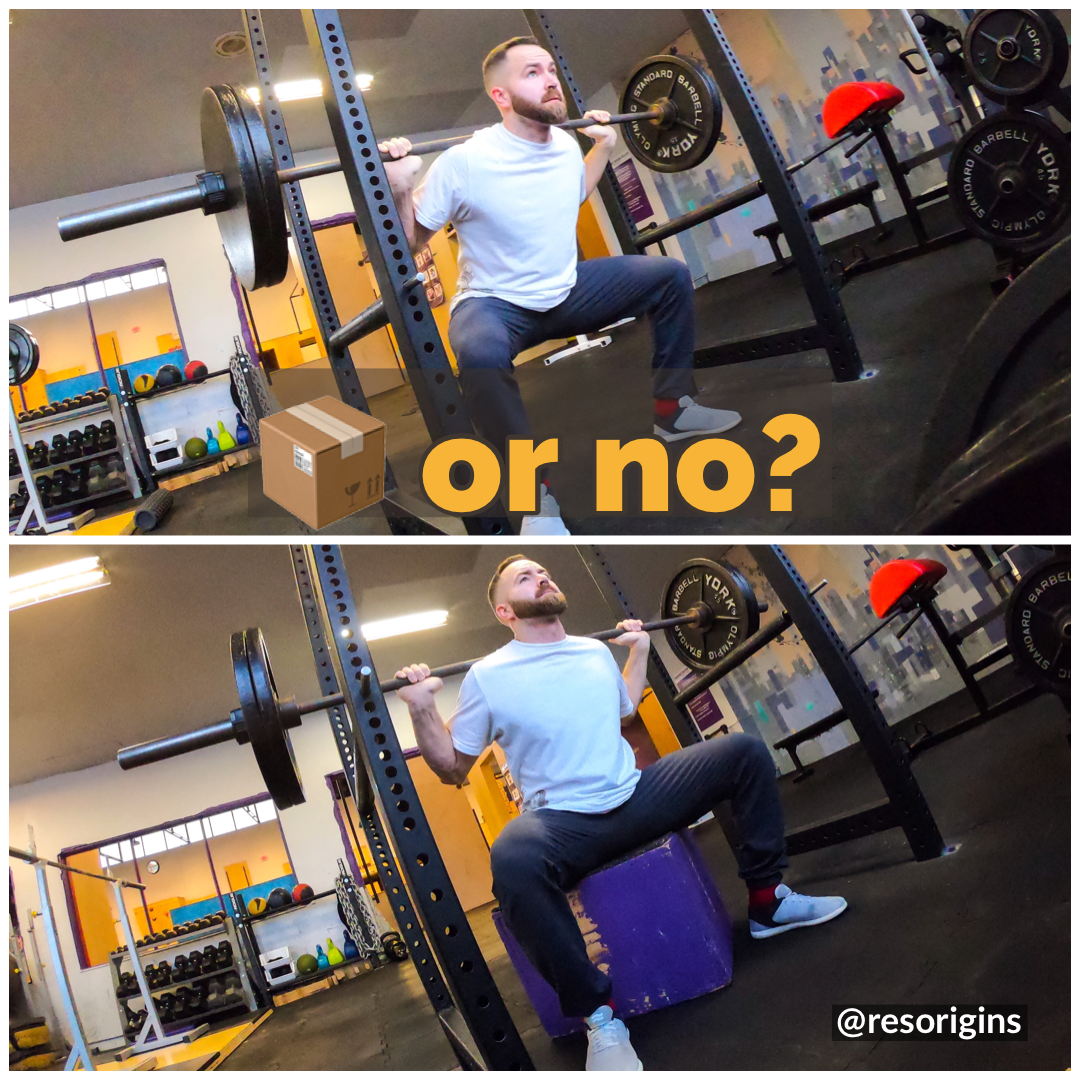
As mentioned above the next block will focus on improving maximal strength in one lower body movement and one upper body movement. I recommend choosing a squat variation for the lower body movement over a deadlift variation. Deadlifts can be great, but maximal lifts performed by novice to intermediate lifters often become more of a slow back extension and less of a knee/back extension working together. If you happen to have a deadlift set up you really like that gives you a good leg drive, then by all means use it in place of squatting.
I also recommend Box Squats over Squats for most parkour athletes.
The box squat is performed by setting up a box or bench of a specific height, so that when you squat on it you are in a parallel-squat (when the crease of the hip is parallel to the top of the knee) or higher. You can test a box height by squatting down to it with an empty bar on your shoulders and seeing if you can control your squat all the way down without suddenly dropping an inch or two on to the box. Unlike a traditional back squat you should avoid having your knees track forward. focus on pushing your hips back as you squat down.
Once you have found the correct box height for you, you can perform the same movement by pushing your hips back as you squat down to the box. Do not relax on the box. You want to pause, but keep tension. Explode upwards to finish the squat.
The benefits to performing box squats over traditional back squats are as follows:
- More posterior chain recruitment. The box squat encourages you to sit back and load your glutes/hamstrings more than a traditional back squat, which can favour a knees further over toes positions.
- Consistent range of motion. Most novice to intermediate lifters cannot maintain the same level of squat depth when they reach maximum loads. The box squat allows you to be able to hit the same range of motion every time.
- The box squat is easier to learn. Squat depth and achieving maximal/optimal depth can be tricky for a lot of athletes. Butt-winking and quarter squatting is often on full display. Box squats take a lot of the work out of learning a new skill.
- Static overcoming dynamic strength. Box squats do not use a stretch reflex like a traditional squat. Athletes already perform a lot of fast lengthening and shortening of muscles when jumping. Box squats can help develop explosive power that doesn’t rely on that same elasticity. Both qualities are important for overall speed and power output, but if an athlete is already performing a lot of sprinting and jumping they are already getting a lot of elastic/reactive work done.
Of course, you can choose to improve your squat during this block if you are comfortable with the exercise and enjoy the benefits of it.
STRENGTH BLOCK
The Strength Block has the option of lasting 6 weeks or 11 weeks. I suggest making your decision based on your yearly calendar and how much time you can afford to improve your maximal strength. I would recommend the 6 week block for athletes who are entering the program having maintained their strength. The longer 11 week block would be more suitable to athletes who have not been consistent with keeping their strength up. You could also assume that 11 weeks of strength preparation would be stronger than 6 weeks.
Just like in the foundation block template you have flexible options for reps, sets and percentages being lifted. You will perform the same primary movement in WORKOUT 1 and 2, in order to improve maximal strength in that movement. Do not perform more than one primary movement for your upper body and one primary movement for your lower body. Sprinting, Jumps, and Dynos will continue to be part of this block, but with less emphasis due to the greater demands of the strength training.
Schedule
Monday – Sprinting / Upper Body WO2
Tuesday – Jumps / Lower Body WO1
Wednesday – Off / Aerobic / Recovery
Thursday – Dynos / Upper Body WO1
Friday – Lower Body WO2
Saturday – Off / Aerobic / Recovery
Sunday – Off / Aerobic / Recovery
Schedule + Parkour Workouts
Similar to the Foundation block, parkour workouts should be done after workouts, and a proper session can be done at the end of the week.
Monday – Sprinting / Upper Body WO2 / PK Drills
Tuesday – Jumps / Lower Body WO1
Wednesday – Aerobics / PK Drills
Thursday – Dynos / Upper Body WO1
Friday – Lower Body WO2
Saturday – Aerobic / PK Session
Sunday – Off / Aerobic / Recovery
Primary Lifts Progression

The above tables are loosely based off of a Russian Pyramid template. A pyramid has a wide base and a narrow peak. This is represented in the programming in two ways:
- You start each primary movement with lower intensity and higher volume “work-up” sets before performing the “work” sets.
- The first week of the program begins with you performing the primary movement for 20-25 total reps at 75-80% and gradually progresses over weeks to where you are performing only 4-6 reps at 90-95%
By performing high volume at lower weights you can perfect your technique which is a big factor in getting better/stronger at any movement. Think of a movement like a squat or a chin-up as a skill that your body will get more accustomed to by putting in more repetitions. The Russian Pyramid is based off of this principal, that the athlete should be performing a high volume of technical reps at lower intensities, and a lower volume of reps at higher intensities. This is not the only means to build strength, but it is a highly effective one for athletes at any level, and one I continue to fall back on.
The work-up sets for each workout should be as follows:
*Bonus: Perform a set with just an empty bar for 10 reps.
45% x 8-10
55% x 6-8
65% x 5-6
MONDAY – Sprinting / Upper Body WORKOUT 2
A. Sprinting Drills: Perform each of these 1-3 times before your sprinting work.
- A-March
- A-Skip
- Running-A
B. Short Sprints: Pick one of the following variations for a 20m (or more) Sprint and Perform 6-10 Sprints with 1-3 min rest between them.
- Split-step start
- 3 or 4 point start
- Fly-in (gradually gain momentum, and then hold for 20m)
C. Upper Body Primary Movement: Choose one movement for the duration of the training block. See “Primary Lifts Progression” for reps/sets.
- Weighted Chin-Ups
- Weighted Pull-Ups
- Barbell Rows
D. Pressing Movement – Pick one of the following and do 40-60 total reps.
- Bench Press
- Incline Press
- DB Incline Press
- DB Bench Press
- Dips or Weighted Dips
- Push Ups
E. One for the Delts – Pick one of the following for 40-60 total reps.
- DB Lateral Raise
- L-lateral Raise
- Band or Cable Lateral Raise
- DB Military Press
F. Elbow Flexors / Extensors Superset – Don’t feel like listing all the possibilities, but pick two exercises and hit 12-20 reps of each for 3 sets.
- Bicep Curls
- Tricep Extensions
TUESDAY – Jumps / Lower Body WORKOUT 1
A. Jumping Movement: Pick one of the following and do 3-5 reps for 5-8 sets. Rest 1-3 min between sets.
- Broad Jumps
- Box Jumps
- Vertical Jump
- Plyos
- Bounding (Strides)
B. Lower Body Primary Movement: Choose one movement for the duration of the training block. See “Primary Lifts Progression” for reps/sets.
- Squats
- Box Squats
- Deadlift
C. Unilateral Quadriceps Movement: Choose one of the following for 8-12 reps (24-50 Total)
- Step Ups
- Bulgarian Split Squats
- Reverse Lunge
D. Hamstrings / Posterior Chain Movement: Choose one of the following for 8-12 reps (24-50 Total)
- Glute Ham Raise
- GHR Push Up + Eccentric (mega soreness)
- Swiss Ball Glute Bridge + Leg Curl
- Romanian Deadlift (mega soreness)
E. Weighted Abdominal Movement – Pick one and hit 30-40 total reps.
- Leg Raises
- Ab Wheel
- Weighted Sit-Ups
F. Gastrocnemius / Calves Movement – Pick one and hit 40-60 total reps.
- Single Leg Calf Raises
- Weighted Calf Raises
- Weighted Seated Calf Raises
WEDNESDAY – Off / Aerobic / Recovery
THURSDAY – Dynos / Upper Body WORKOUT 1
A. Dynamic Climbing Movement – Pick one of the following and perform 3-5 reps, for 15-30 total reps.
- Dyno
- Climb-Up
- Cat-Back
B. Upper Body Primary Movement: Same movement as Workout 2. See “Primary Lifts Progression” for reps/sets.
- Weighted Chin-Ups
- Weighted Pull-Ups
- Barbell Rows
C. Pressing Movement – Pick one of the following and do 40-60 total reps.
- Bench Press
- Incline Press
- DB Incline Press
- DB Bench Press
- Dips or Weighted Dips
- Push Ups
D. Horizontal Pulling Movement – Pick one of the following and do 40-60 total reps.
- DB Rows
- Band or Cable Row
- Barbell Rows
- Inverted Rows
Di. Vertical Pulling Movement (if primary movement is Barbell Rows)
Pick one and do 15-30 Total Reps. At least 3 sets.
- Pull Ups
- Chin Ups
- Band Assisted Chin Ups
E. Shoulder DB Complex: Perform 8-12 Reps of each exercise with as little rest as possible. Rest 1-3 min between sets. Complete 2-3 sets.
- DB Lateral Raise
- DB Rear Delt Fly
- DB Snatch + Military Half Press
F. Elbow Flexors / Extensors Superset – Don’t feel like listing all the possibilities, but pick two exercises and hit 12-20 reps of each for 3 sets.
- Bicep Curls
- Tricep Extensions
FRIDAY – Lower Body WORKOUT 2
A. Lower Body Primary Movement: Same movement as Workout 1. See “Primary Lifts Progression” for reps/sets.
- Squats
- Box Squats
- Deadlift
B. Jumping Movement: Pick one of the following and do 1-2 Reps for 2-3 Sets
- Broad Jumps
- Box Jumps
- Vertical Jump
- Plyos
- Bounding (Strides)
C. Unilateral Quadriceps Movement: Choose one of the following for 8-12 reps (24-50 Total)
- Step Ups
- Bulgarian Split Squats
- Reverse Lunge
D. Hamstrings / Posterior Chain Movement: Choose one of the following for 8-12 reps (24-50 Total)
- Glute Ham Raise
- GHR Push Up + Eccentric (mega soreness)
- Swiss Ball Glute Bridge + Leg Curl
- Romanian Deadlift (mega soreness)
E. Gastrocnemius / Calves Movement – Pick one and hit 40-60 total reps.
- Single Leg Calf Raises
- Weighted Calf Raises
- Weighted Seated Calf Raises


